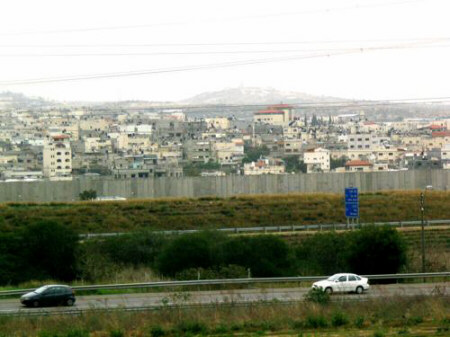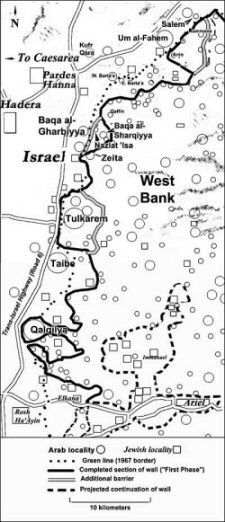Margaret Strother Shalev
 We all know that the wall is Israel’s de-facto border. Only the most sensitive Israelis weep for the destruction that edifice has caused; daily bus-riders (read: the poor, who always suffer most) weigh its environmental and aesthetic destruction, not to mention the brutal inconveniencing of thousands of Palestinians, against the twisted hulks of burning buses and the blood and mangled body parts of children and their parents. For all that, there are still those who weep, those who go daily to protests at the building site and get arrested in front of it. I could be cynical and point out that they don’t ride city buses to get there, they take one of the family cars… but in fact, I admire them, and their compassion.
We all know that the wall is Israel’s de-facto border. Only the most sensitive Israelis weep for the destruction that edifice has caused; daily bus-riders (read: the poor, who always suffer most) weigh its environmental and aesthetic destruction, not to mention the brutal inconveniencing of thousands of Palestinians, against the twisted hulks of burning buses and the blood and mangled body parts of children and their parents. For all that, there are still those who weep, those who go daily to protests at the building site and get arrested in front of it. I could be cynical and point out that they don’t ride city buses to get there, they take one of the family cars… but in fact, I admire them, and their compassion.
But for an apartment-hunter, the wall is not an abstraction; it's a necessary part of the deal. Is Karnei Shomron inside or outside the wall? I set to find out, and I set a rule for myself: I will try not to use anything but right-wing and “neutral” news sources. I’m curious about the settlers’ perspective, whether they even admit yet that there is a wall, let alone a de-facto border.
 After an hour, I almost give up. I have found lots of stuff about Neve Aliza: Christian Friends of Neve Aliza; a sad letter, to no one in particular, from a woman who raised her family there — much safer than Brooklyn, she insisted — and whose two children were murdered there 20 years later. Nothing about a fence. Then I redefine my search: Karnei Shomron, Security Fence. Suddenly I see a rather different picture: The newspapers are saying that Karnei Shomron is in fact one of the flashpoints in the route of the “wall.” It’s actually a relatively far-flung town – those 12 kilometers from Kfar Saba are like a hundred miles in this cramped region – and would require a bulge (technically known as a “finger”) in the planning of the barrier to encompass it. This was evidently part of the original plan, but after pressure from the US, the fence has become relatively finger-less. Karnei Shomron and other, even larger communities, are to be excluded from the final route of the fence.
After an hour, I almost give up. I have found lots of stuff about Neve Aliza: Christian Friends of Neve Aliza; a sad letter, to no one in particular, from a woman who raised her family there — much safer than Brooklyn, she insisted — and whose two children were murdered there 20 years later. Nothing about a fence. Then I redefine my search: Karnei Shomron, Security Fence. Suddenly I see a rather different picture: The newspapers are saying that Karnei Shomron is in fact one of the flashpoints in the route of the “wall.” It’s actually a relatively far-flung town – those 12 kilometers from Kfar Saba are like a hundred miles in this cramped region – and would require a bulge (technically known as a “finger”) in the planning of the barrier to encompass it. This was evidently part of the original plan, but after pressure from the US, the fence has become relatively finger-less. Karnei Shomron and other, even larger communities, are to be excluded from the final route of the fence.
With my search clogged with outdated news reports, inflammatory Palestinian and right-wing Jewish claims, World Court rulings and Supreme Court rulings, it’s not clear to me what will be the fate of Karnei Shomron. Of course, Karnei Shomron is far across the "Green Line," which Palestinians claim as the border of an independent Palestinian state; any ingress by the wall has been viewed as a violation of international law. (Israel argues that because the Green Line marks an armistice line on land once occupied illegally by Jordan, not a previously existing internationally-recognized border with Palestine, the law is far from clear. Israeli lawyers are very deft, but the World Court isn’t interested.) In the 2000 negotiations, both sides agreed in principle that Israel’s final borders would bulge in places to encompass Jewish population centers close to the eastern side of the Green Line, and that Israeli territory elsewhere in along the Green Line would be given to the Palestinian state as compensation. Nonetheless, when Israel acted unilaterally to build the separation wall, such agreements evaporated into the ether of history, just like all those other old partition plans from 1937, 1938, 1947.
The most recent maps don’t enclose Karnei Shomron within the proposed final route of the fence. The Greenberg family must have seen this map. That's why their place is such a bargain: it's in Palestine. And so I pretty much lost interest in renting the spacious townhouse, despite the six bedrooms and the garden. It would be one thing to raise my kids in a border community, staring at that wall and worrying about what happens when someone figures out how to shoot things over it. Quite another thing, however, to strand my family on some hilltop in Palestine, admiring the views and studying Torah on the sacred spot where biblical events took place, all the while praying that some non-sleeping, secular guard is vigilantly keeping my community within his scopes.
As a secular lesbian artsy type, I will probably never meet the Greenbergs. But if I ever do run into them on the streets of Tel Aviv, I will welcome them home. Not just to “Israel Proper,” not just as returnees from the nightmare of the occupation. But as Olim, albeit Olim Vatikim (long-time immigrants), as ex-Americans, as Zionists: fools like me.

May, 2005
Artists on 9/11 and the war on/of terror
October, 2004
Inside Israel's curious opera ban
May, 2004
May, 2004
Catching up with some famous refugees
May, 2004
Freedom and the Ordinary
April, 2004
April, 2004
A translation of the November, 2003, interview by an Israeli tabloid with four former Israeli intelligence directors.
December, 2003
Is Zionism Colonialism?
June, 2003
The new Israeli smash hit
May, 2003
Anxiety on the National Mall
January, 2003
Avoiding the obvious Jewish responses to the mideast crisis: a response
to Jay Michaelson
June, 2002
It's a lonely world when you're both an anti-globalization leftist and a
Zionist.
May, 2002



Golden Calf
Jacob J. Staub
Israel on Campus
A Conversation with Sam Brody and Zach Gelman
Samaria for Rent
Margaret Strother-Shalev
Does Mysticism Prove the Existence of God?
Jay Michaelson
Patrolling the Boundaries
of Truth
Joel Stanley
The Wheel World
Dan Friedman
Archive
Our 700 Back Pages
Zeek in Print
Summer 2005 issue now on sale
About Zeek
Mailing List
Contact Us
Subscribe
Tech Support
Links
Limited Time Offer
Subscribe now and get
two years of Zeek for
25% off regular price.
Click this button
to purchase:
From previous issues:
The Stable
Hiding your Sins
Sufganiyot
Ira Stone
Hal Sirowitz
Rachel Barenblat
 Email us your comments
Email us your comments